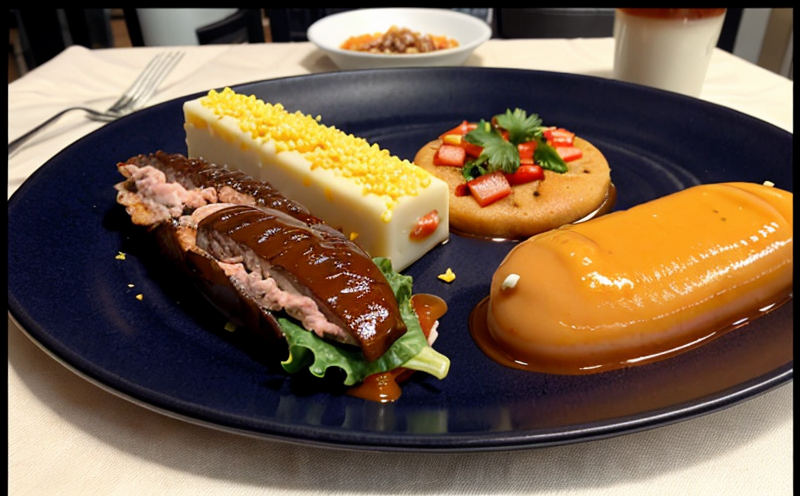ISO 1186 Overall Migration into Food Simulants
The ISO 1186 standard specifies the procedure for determining overall migration from packaging materials used in contact with food. This testing ensures that any chemicals or substances migrating from the packaging do not pose a risk to human health when the packaged product is consumed.
This test involves submerging packaging samples into food simulants (such as water, ethanol, and vegetable oil) for a specified period under controlled conditions. The extracted substances are then analyzed by gas chromatography-mass spectrometry (GC-MS), liquid chromatography-mass spectrometry (LC-MS), or other analytical techniques to identify potential migrants.
The test is particularly critical in the food and beverage packaging industry, as it helps ensure that the materials used do not contaminate the packaged product with potentially harmful substances. This testing supports compliance with international standards such as ISO 1186, which mandates that overall migration must be below a certain threshold to ensure safety.
The process begins by selecting appropriate food simulants based on the type of packaging material and its intended contact with specific types of food. For instance, different simulants may be used for contact with liquids versus solid foods or for high-temperature applications compared to room temperature use.
During the test, samples are prepared according to specified dimensions and weights. The packaging is then submerged in the selected simulant under conditions that mimic real-world storage and distribution environments. After a predetermined time (typically 5 hours), the simulants are analyzed for any detected migrants using sophisticated analytical techniques.
The results of this testing provide critical information on the safety profile of the packaging material, helping manufacturers to make informed decisions about their product safety. Compliance with ISO 1186 is essential for ensuring that food packaging meets regulatory requirements and consumer expectations regarding safety.
| Simulants | Description |
|---|---|
| Water | Used to simulate the conditions of water-based beverages. |
| Ethanol | Suitable for testing alcoholic beverages and spirits. |
| Olive oil | Represents fatty food simulants like oils or fats in packaging. |
| Milk | Used when simulating the migration into dairy products. |
The overall migration limit (OML) is a critical parameter used to ensure that no harmful substances migrate from the packaging into the food. The OML is typically expressed in mg/m2 for flat materials or as mg/L for liquid simulants.
Compliance with ISO 1186 is not only mandatory but also serves as a benchmark for the quality and safety of food contact packaging across various industries, from manufacturing to retail. Proper testing ensures that products remain safe throughout their shelf life and distribution channels.
Benefits
- Ensures Regulatory Compliance: Adheres to ISO 1186, ensuring compliance with international standards.
- Protects Consumer Health: Identifies potential harmful substances that could migrate into food products.
- Enhances Brand Reputation: Demonstrates commitment to product safety and quality.
- Reduces Legal Risks: Minimizes the risk of legal action from product contamination incidents.
- Supports Continuous Improvement: Provides valuable data for ongoing process optimization and material selection.
Industry Applications
The ISO 1186 Overall Migration into Food Simulants is widely used across various industries that involve food contact packaging. These include:
- Packaging for beverages (water, soft drinks, beer)
- Dairy products and packaging (milk containers, cheese trays)
- Fresh produce packaging
- Confectionery packaging
- Canned goods packaging
This testing is especially important in the beverage industry where water-based simulants are commonly used. For alcoholic beverages, ethanol simulant tests provide critical insights into potential migration issues.
| Industry | Packaging Type | Migrant Limits (mg/m2) |
|---|---|---|
| Beverages | Plastic bottles, cans | 10 mg/m2 |
| Dairy Products | Paperboard cartons, plastic tubs | 5 mg/m2 |
| Fresh Produce | Ventilated bags, crates | 10 mg/m2 |
The specific limits for migrants vary by industry and packaging type. For instance, dairy products have a lower OML due to their sensitive nature.
EuroLab Advantages
At EuroLab, we pride ourselves on providing comprehensive ISO 1186 testing services that go beyond mere compliance. Our state-of-the-art facilities and experienced technical experts ensure accurate and reliable results:
- Advanced Analytical Equipment: Utilize cutting-edge GC-MS and LC-MS equipment to detect even trace amounts of migrants.
- Experienced Technicians: Our team of experts has extensive experience in food safety testing, providing accurate interpretations of results.
- Comprehensive Reporting: We provide detailed reports that include not only the test results but also recommendations for improvement and compliance with international standards.
- Fast Turnaround Times: Deliver results quickly to ensure timely product launches and distribution.
- Customized Solutions: Tailor our services to meet specific client needs, whether it's a one-time test or ongoing compliance monitoring.
We understand the importance of maintaining high standards in food safety. EuroLab is committed to providing reliable testing that ensures the quality and safety of packaging materials used in contact with food products.





